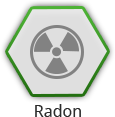Testing Mitigation Maps
RADON
Radon is a cancer-causing, radioactive gas.
You can’t see radon. And you can’t smell it or taste it. But it may be a problem in your home.
Radon enters the average home or building as a result of decaying radium present in the soil and bedrock surrounding the building. Elevated airborne levels are detected in buildings that are old or new, tightly sealed or drafty, with or without basements.
The upward movement of air in a building is known as the “Stack” or “Chimney” effect. This upward drafting creates a vacuum or negative pressure plane in the structure, which draws in radon and other soil gases through openings in the foundation. When this pressure is great enough, it can draw radon gas right through the foundation, even where no cracks exist.
Radon is estimated to cause many thousands of deaths each year. That’s because when you breathe air containing radon, you can get lung cancer. In fact, the Surgeon General has warned that radon is the second leading cause of lung cancer in the United States today. Only smoking causes more lung cancer deaths. If you smoke and your home has high radon levels, your risk of lung cancer is especially high.
Radon can be found all over the U.S. Learn More.
Radon can be found all over the U.S. It can get into any type of building — homes, offices, and schools — and result in a high indoor radon level. But you and your family are most likely to get your greatest exposure at home, where you spend most of your time. Radon comes from the natural highly radioactive heavy metallic decay products, such as, polonium, lead, bismuth and uranium in soil, rock and water and gets into the air you breathe. Radon’s primary hazard arises from inhalation of the gas which tend to collect on dust in the air.
Testing is the only way to know if you and your family are at risk from radon. EPA and the Surgeon General recommend testing all homes below the third floor for radon. EPA also recommends testing in schools.
Testing is FREE with Advanced Health, Safety and Security. Learn More.
Testing is free or relatively inexpensive depending on the type of testing performed. Millions of Americans have already tested their homes for radon.
|
Links For More Information The Risk of Living With Radon? |